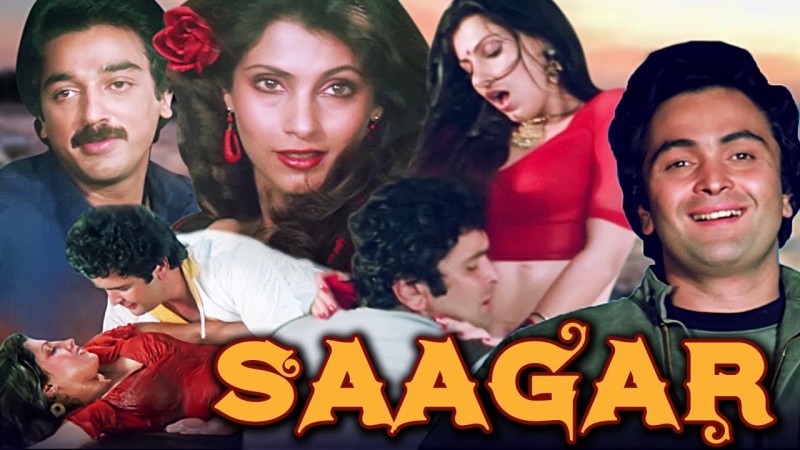
The ground-breaking action movie "Sholay" (1975), which is regarded as a landmark in Indian cinema, is best known as the work of Ramesh Sippy, a name that is synonymous with iconic Bollywood cinema. Following the huge success of "Sholay," Sippy went on to establish himself as a notable director with action films like "Shaan" (1980) and "Shakti" (1982). But with his 1985 film "Saagar," he shocked critics and viewers alike by straying from the action genre and foraying into the world of romance. This article delves into Ramesh Sippy's shift from action to romance while delving into the subtleties of "Saagar."
Ramesh Sippy was admired for his talent for helming exciting blockbusters. A cinematic phenomenon that redefined Indian filmmaking was "Sholay," in particular. It became a cultural touchstone thanks to its endearing characters, thrilling action scenes, and memorable dialogue. After this enormous hit, Sippy continued to experiment with the action genre in films like "Shaan" and "Shakti," further establishing his status as the action king of Bollywood. However, Sippy decided it was time to try out a different genre at the beginning of the 1980s.
Ramesh Sippy's departure from his preferred genre of action films was symbolised by "Saagar" (1985). It was a romantic drama with a complicated love triangle at its centre. Rishi Kapoor, Kamal Haasan, and Dimple Kapadia all played significant roles in the movie, which also had a gorgeous R.D. Burman musical score. Sippy made the risky decision to shift to the romance genre, but he did so with the same commitment and creativity that had made his action films so well-known.
Raja (Kamal Haasan) and Mona (Dimple Kapadia) share a tender romance as "Saagar" takes place against the backdrop of a coastal Goan village. Raja's love for the vivacious and affluent Aarti (Rishi Kapoor), however, causes their idyllic existence to be upended. This creates the framework for a love triangle that investigates issues of friendship, love, and sacrifice.
As he deftly handled the nuanced emotional nuances of the characters, Ramesh Sippy's storytelling skill was on full display. Raja's heart is torn between the two women, and the conflict between Mona and Aarti's personalities gives the story more depth. While Aarti, a contemporary, self-assured woman from a wealthy background, symbolises aspiration and urbanity, Mona, a down-to-earth and kindhearted village girl, stands for innocence and simplicity.
R.D. Burman's soul-stirring score for "Saagar" was one of the film's most notable aspects. Melodic songs from the soundtrack, such as "Saagar Kinare," "O Maria," and "Chehra Hai Ya Chand Khila Hai," became instant classics and greatly aided in the success of the movie. Music lovers still treasure the soundtrack because it enhanced the romance depicted on screen.
For its narrative, performances, and Ramesh Sippy's seamless transition into the romance genre, "Saagar" won praise from critics. The film received praise for its beautiful cinematography, which perfectly captured Goa's natural beauty, and for its heartfelt portrayal of love. Sippy's shift in filmmaking approach was well received by the public, which helped "Saagar" become a financial success. Additionally, it received a number of honours, including the National Film Award for Best Popular Film Offering Filling Entertainment.
"Saagar" represented a crucial career turning point for Ramesh Sippy. It demonstrated his versatility as a director, demonstrating that he could succeed in genres other than action. This change broadened his artistic horizons and showed that he was just as skilled at choreographing intense action sequences as he was at capturing the nuances of human emotions.
The movie helped the lead actors' careers as well. With his subtle portrayal of Raja, Kamal Haasan, who was already well-known in the South Indian film industry, gained popularity in Bollywood. Rishi Kapoor, a seasoned actor, added another feather to his cap with his role as Aarti's character. Dimple Kapadia won praise for her portrayal of the endearing Mona.
Ramesh Sippy's decision to break from his persona as an action director and enter the world of romance with "Saagar" demonstrated his artistic versatility and deftness in the art of storytelling. With its compelling story, endearing characters, and soul-stirring music, the movie made an enduring impression on Indian cinema. It continues to be evidence of Sippy's capacity to cut across genres and present audiences with engaging stories. In addition to confirming Sippy's status as a cinematic legend, "Saagar" showed that great directors are distinguished by their capacity to adapt to and succeed in a variety of narrative contexts.
When Anupam Kher Swapped Villainy for Complexity in Bollywood
A Landmark in Indian Cinema with Amitabh Bachchan at Its Helm
"Dil Se..." Parade Scenes from India's 50th Independence Anniversary